After the wedding I went to Scotland on a press trip for almost a week. This trip was focussed on something called screen tourism or ‘set jetting’.
Outlander has been my comfort watch on TV ever since I first discovered it in 2017. I loved the TV series but the audiobooks are even better. Audiobooks rely on the talent of the actor narrating them: Davina Porter is brilliant. She can do all the voices: the men, the women, the kids, Scots, English, American. My favourite thing is to listen while driving up to and around Scotland, but I also listened to them when travelling around India.
The books are written by Diana Gabaldon, an American professor who thought she’d have a go at a historical novel. Outlander is genre busting: sci-fi, occult, romantic, historical and war all at once.
The main character is Claire Beauchamp, a Second World War nurse who goes on holiday to Scotland with her husband who has Scottish ancestry. She travels through time to meet an 18th century highlander Jamie Fraser. It sounds preposterous but it works.
There is quite a lot of sex in the books and the series: fortunately the leading actors, Irish ex-model Catriona Balfe and scotsman Sam Heughan have great chemistry. But there is also lived history, information about medicine in the 18th century, and the tragic circumstances of how the Highland clans were wiped out after the battle of Culloden.
I like that the lead character is a woman who gets to be brave and interesting. The love story draws you in compellingly. Diana Gabaldon based the stories on her long marriage. She said she wanted to explore the ups and downs of a happy marriage.
In 2022 I went up to Stirling, to Gartmore House, where they run residential art and craft courses. I spent a week learning to make an 18th century corset.
I’ve visited Culloden, which is on an eery swamp near to Inverness. There are stones marking all the clans, including a Fraser stone. In writing other stories about Outlander, I’ve spoken to several historians and they say that Gabaldon’s history is very accurate, it’s well researched.
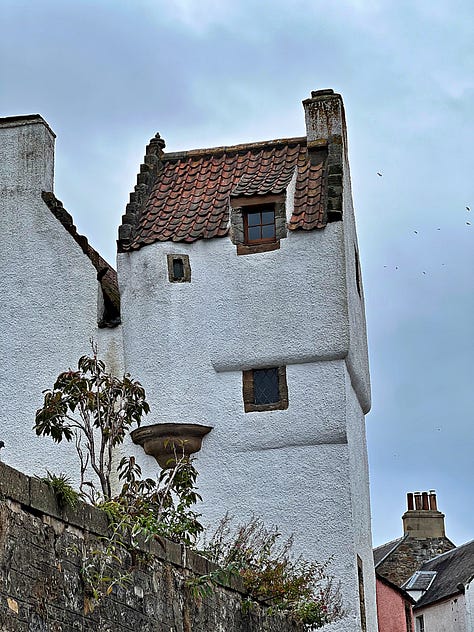
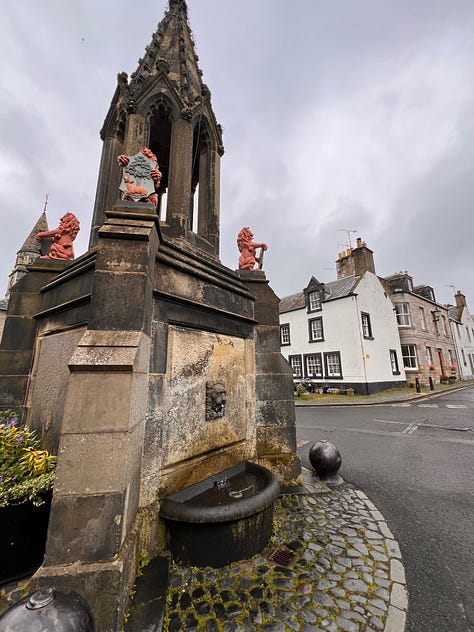
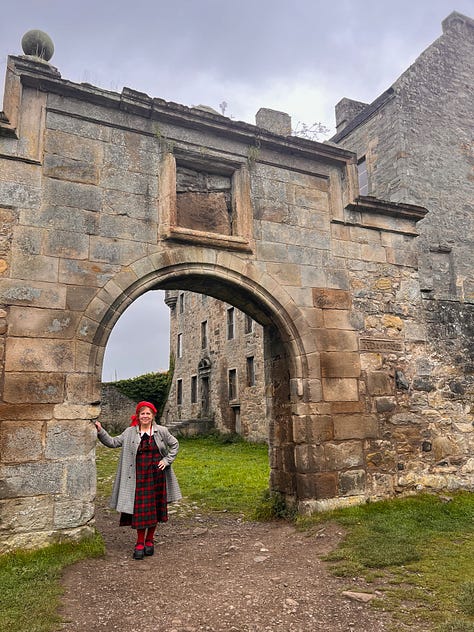
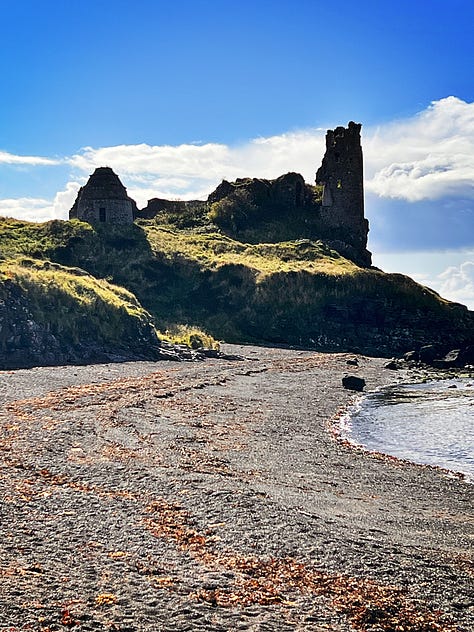

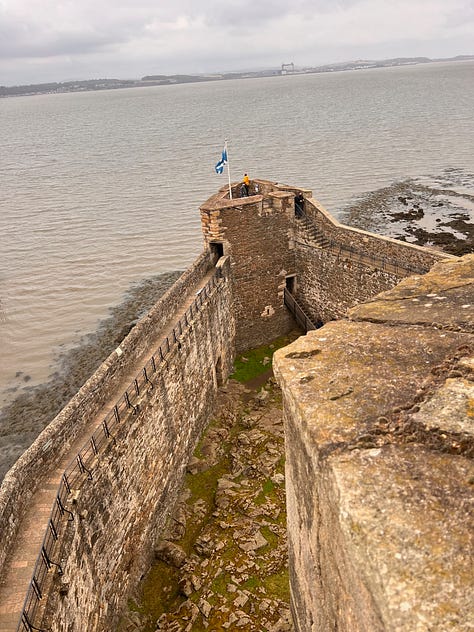

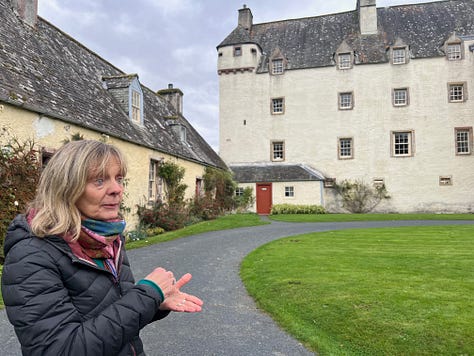

This time I got to visit several Scottish castles, some of which were used as filming locations and others were probably used as a basis for the history in the books. I went to Doune Castle, used as Castle Leoch; Dean Castle, used as Lord Lovat’s castle; Blackness, a misty fortress, used as a prison; Newhailes House, where some of the North Carolina scenes were filmed; Troon, used as a sea port; a 17th century village Culross, where the witch Geilis Duncan lived; Falkland, which represented Inverness; and the fictional Lallybroch, Jamie’s home, which is a ruin called Midhope Castle. The latter charges £7 to visit the ruin, and has about 2000 visitors a day. They are raking it in.
I found it interesting when speaking to some French tourists at Midhope that while Outlander is dubbed into French using different actors, when the characters talk in Gaelic, the voice of Jamie reverts to the original actor, Sam Heughan’s voice. Isn’t that a bit weird? I asked. We are used to it, they shrugged.
I also visited Traquair House which wasn’t used in the series but I’m fairly certain Gabaldon went there to do research. The first female laird, pale blue eyed Lady Catherine Maxwell Stuart, showed us around. She was very nice, an aristo who has stood for the Labour Party. Her family have been catholic, and therefore Jacobite (supporters of the Stuart royal line) for centuries. Her house has priest holes and secret stairways, necessary for escaping religious prejudice after the reformation. One of her ancestors helped her husband escape from the Tower of London, by dressing him up as a female servant.
Scotland has incredible scenery. The people are lovely. I found myself snapping at one of the guide’s (from Rabbies, I highly recommend them) when he slagged off Scottish food. Scotland has some of the best ingredients in the world. The food isn’t refined, but is of great quality, hearty and comforting. One of my favourite dishes is Cullen Skink - smoked haddock, potato, leek and thick creamy soup. I love porridge, especially with berry compote. And since becoming an Outlander fan, I like to watch the show with a wee dram of peaty smoky whisky.
As an English woman, I don’t get a say but I don’t agree with Scottish independence. In all honesty, I do find the relentless Scottish resentment of the English a bit tiresome. The Scottish have loads of English money spent on them, their lives are hugely subsidised. They have free education, free prescriptions, grants for solar, lots of advantages.
Most of England has Scottish blood, we are not distinct peoples. I have a Scottish great grandmother from Arbroath. I find the SNP’s politics corrupt, cynical and virtue signalling, especially with regard to female single sex spaces and safety. Never forget that the Scottish were some of the biggest slave traders (hence why many Caribbean families have Scottish surnames - people like Naomi Campbell), and rather good at running the colonies in the name of the British empire. Scottish people are smart.
I fear having a border between Scotland and England because realistically, immigrants will go to Scotland (where they are desperate for more people) and minute they have a chance, cross over to England. This is what is happening in Ireland already.
Immigration is great but there is a limit. England will end up losing our precious welfare state due to the pressure of numbers. That process is happening already.
Recipe for Cullen Skink
Cullen Skink soup
Serves 6
Ingredients
500g dyed or undyed smoked haddock, skinned, de-boned
1 bay leaf
generous knob of butter
1 brown onion, finely chopped
1 leek, washed, cut into chunks
4 medium potatoes, cut into chunks
500 ml whole milk or half milk/half double cream for a luxury version
Bunch of chives, finely chopped
Instructions
Put the fish into a pan and cover with cold water. Add a bay leaf and bring gently to the boil. Remove from the pan and set aside to cool.
Melt the butter in another pan on a medium-low heat, adding the onion and the leek. Cover and allow to sweat, without colouring, for about 10 minutes until softened. Season with black pepper.
Stir in the potatoes, then pour in the haddock cooking liquor and bring to a simmer.
Break the haddock into flakes, reserving some for the garnish. Lift out a few potatoes and leeks, also for garnish.
Add the milk or cream and half the haddock to the pan, stir then blend.
Season and serve the soup with a garnish of potato, leek and haddock in each bowl, plus a sprinkling of chives.




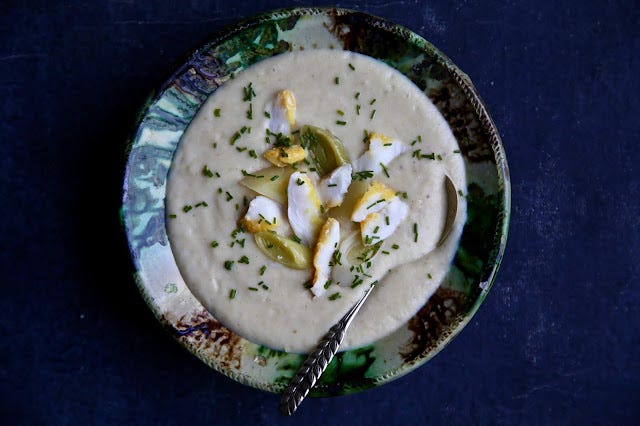
When the weather cools, everything seems a bit better with a wee dram of peaty smoky whisky. 😁